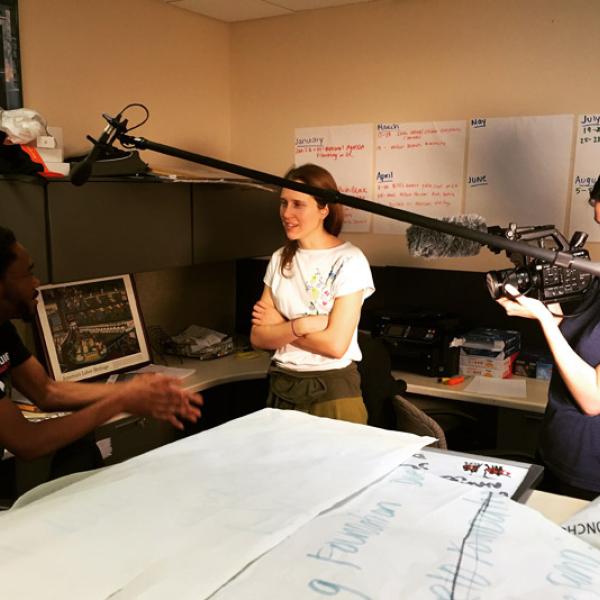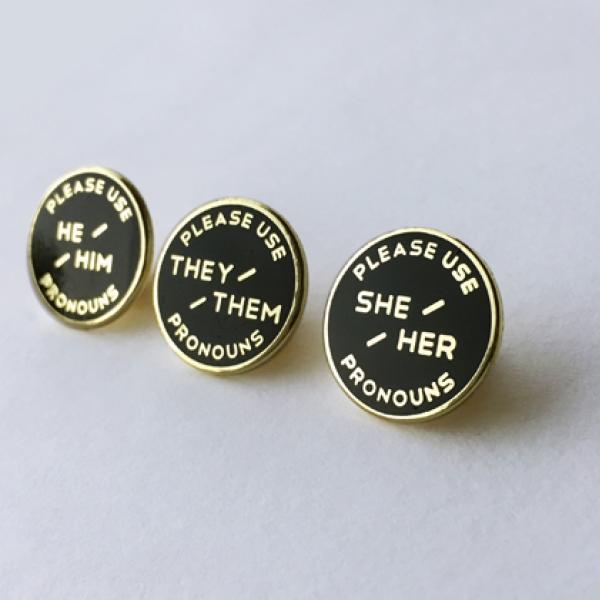From Pride March to Museum Exhibit
Activist New York Highlights Intersectional Queer Politics
Friday, April 29, 2022 by
During the 2021-2022 academic year, I have been part of MCNY’s vibrant Education team as a Ph.D. scholar on a Public Humanities Fellowship. The Education department leads field trips, organizes webinars, and hosts school classes working on research projects connected to the Museum’s exhibitions and holdings–and so much more.
While my primary responsibilities are in Education, I’ve felt genuinely fortunate to collaborate with both the Public Programs and Curatorial departments during my time here. One of these collaborations involved working with Sarah Seidman, the Puffin Foundation Curator of Social Activism and the curator of the ongoing exhibition Activist New York: I participated in curatorial meetings about the shape the newly installed section on current events would take, and then wrote a few object descriptions for artifacts we selected for display.
In an amusing turn of events, the Museum requested to borrow an object from me for this new section of Activist New York. Last summer, I joined the New York City Reclaim Pride Coalition’s alternative–and more avowedly political–Pride march in the city, the Queer Liberation March. The March exists because, as the coalition’s website says,“ the [NYC Pride] Parade in NYC had gone too far—too far from the spirit of the Stonewall Rebellion.” In contrast, the Queer Liberation March sees its mission as one free of corporate interests, institutional politics, and law enforcement:
The Queer Liberation March says “NO” to corporate sponsorship bribes, and rainbow covered anything. We say “NO” to involving police as the protectors of our spaces, as they show daily that they are not up to the task. We say “NO” to politicians ’grandstanding, trading in the struggles of Queer people for votes and political posturing.
At the 2021 march, I ended up holding up a poster printed by the organizers of the march. The poster read “This Is Stolen Lenape Land,” with the name of the event, date, and website printed in smaller type at the bottom. That poster is now on display at the Museum.
I was glad to strain my arms for a few hours holding that poster aloft as we walked down from Bryant Park towards Greenwich Village, alongside giant puppets and a handful of close friends of mine (one, a former organizer with the South Asian Lesbian and Gay Association, in immaculate sari drag!) because it centers an issue that has, until very recently, been relegated to the margins of more mainstream iterations of the LGBTQ movement in the United States: Indigenous sovereignty.
Whereas queer activists in Canada have more readily taken to amending the “LGBTQ” acronym and appending it with a “2” for Two-Spirit-identified Indigenous people, i.e. 2LGBTQ, it’s still rare to see that usage in the U.S. A symbolic inclusion of queer Indigenous people is only the most basic of changes needed to transform the LGBTQ movement in the United States into being truly intersectional and inclusive of all queer people.
Writing for the art blog Hyperallergic on New York City’s hosting of WorldPride in 2019, the international pride parade that takes place in a different country each year, the queer Cherokee scholar Joseph M. Pierce observed that even as WorldPride NYC was “the largest gathering of two-spirit people ever to march in the parade,” numerous non-Indigenous queer people showed up to this gathering in “Indian costumes,” perpetuating the centuries-long derogatory practice of “playing Indian.” He writes:
Suddenly, from the corner of my eye, I noticed a group of five men wearing elaborate headdresses and loincloths. I was dazed by this flash of fuchsia, turquoise, tangerine, and scarlet. At first, I wondered why they weren’t marching with us. But no tribe actually dresses like that...they’re playing Indian for Pride.
I shuffled next to one of them and asked, “What tribe are you from?”
“Oh, we don’t belong to a tribe,” one of the men responded. “We dressed up like this for Pride. It’s just a costume.”
Even worse, other participants in the Pride parade lined up to take selfies with this group. For Pierce, “[t]his objectification perpetuates the erasure of Indigenous peoples; it undermines our sovereign right to express ourselves as human beings.”
Racialized performances of blackface, minstrelsy, and playing Indian are inherently dehumanizing to Indigenous and Black queer people. Queer people of color (QPoC) make up a large swathe–if not the majority–of LGBTQ New Yorkers, and a Pride Parade in the city that is not intersectional and inclusive of all queer people should be simply untenable, especially in 2022. It is worth noting here that the relatively recent addition to MCNY’s Activist New York exhibition on trans activism, does in fact highlight the centrality of trans women of color in the history of trans activism in the city, particularly Sylvia L. Rivera and Marsha P. Johnson.
However, the sign “This Is Stolen Lenape Land” also prompts us to think about what queer pride means…on stolen land. If queer New Yorkers include Indigenous New Yorkers, shouldn’t a holistic queer politics highlight issues that impact Indigenous New Yorkers, such as demands for the restoration of Indigenous sovereignty and #LandBack? And if you’re wondering how significant New York’s Indigenous population is, as explored in the Museum’s 2019 exhibition Urban Indian: Native New York Now, New York City has the largest urban American Indian population in the country. An exhibition put on by MCNY Just before the pandemic, Urban Indian was dedicated to highlighting the lives of Native American New Yorkers.
As Activist New York is continually updated to reflect the times we live in and to include a wide spectrum of contemporary social movements, it is heartening to see that attempts to enact coalitional politics and to build intersectional social movements are being given the pride of place they deserve. Maybe this year, you will join us at the Queer Liberation March and hold up another slogan that aims to highlight the connections between social movements and historical experiences!
This blog post was written by Smaran Dayal, Public Humanities Fellow at the Museum of the City of New York.






